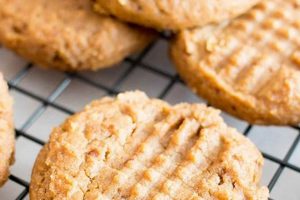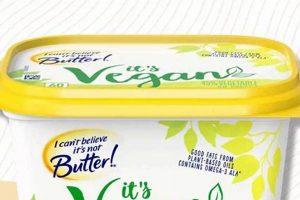The central question concerns whether clarified butter, traditionally known for its rich flavor and culinary uses, can be replicated in a plant-based form. Clarified butter, in its conventional preparation, is a dairy product made by simmering butter to remove water and milk solids, leaving behind pure butterfat. The query, therefore, examines the potential for a non-animal derived product to achieve a similar texture, flavor profile, and functionality in cooking and baking.
The significance of this exploration lies in catering to dietary restrictions and lifestyle choices. Individuals following a plant-based diet, or those with lactose intolerance, may seek alternatives that provide a comparable experience to the traditional dairy product. Replicating the attributes of clarified butter without using animal products offers a potential solution for a wider range of consumers, expanding culinary options and accommodating diverse nutritional needs.
The following sections will delve into the composition of conventional clarified butter, explore plant-based substitutes attempting to emulate its properties, analyze the challenges in achieving a true vegan equivalent, and discuss the current landscape of available plant-based butter alternatives. These topics will further illuminate the complexities involved in addressing whether a dairy-derived product can be authentically reproduced using exclusively non-animal ingredients.
Considerations for Plant-Based Alternatives to Clarified Butter
The following guidelines address factors to consider when seeking plant-based products designed to mimic the functionality and characteristics of clarified butter. These recommendations aim to inform selection and utilization of such alternatives in culinary applications.
Tip 1: Evaluate Ingredient Composition. Scrutinize the ingredient list to identify the primary fats and oils used. Coconut oil, shea butter, and refined vegetable oils are common bases. Understanding the fat profile can indicate melting point, smoke point, and overall suitability for different cooking methods.
Tip 2: Assess Smoke Point. Clarified butter is known for its high smoke point. Plant-based alternatives should ideally possess a similarly high smoke point to prevent burning and maintain stability during high-heat cooking. Products with a listed smoke point above 375F (190C) are preferable.
Tip 3: Examine Flavor Profile. Some plant-based butters are formulated with added flavorings to simulate the nutty taste of clarified butter. Compare the aroma and flavor of different products to determine which best suits intended culinary purposes. Be aware that certain flavorings may be artificial.
Tip 4: Analyze Texture and Consistency. Clarified butter is typically smooth and liquid at room temperature or when melted. Evaluate the texture of the plant-based alternative, ensuring it is homogenous and readily melts without separating or becoming grainy. This impacts final dish texture.
Tip 5: Consider Water Content. Traditional clarified butter has a very low water content. Plant-based alternatives may contain varying amounts of water, which can affect browning and crisping during cooking. Opt for options with lower water content when using in recipes where a drier fat is desired.
Tip 6: Investigate Processing Methods. The method of processing plant-based butters can influence their quality and stability. Look for products that have undergone refining processes to remove impurities and improve heat tolerance. This may be detailed on the product label or manufacturer’s website.
Tip 7: Test in Small Batches. Before committing to using a plant-based butter substitute in a large recipe, test it in a small batch to assess its behavior and flavor contribution. This helps avoid undesirable outcomes in the final dish.
Careful attention to these considerations will aid in selecting plant-based alternatives that most closely replicate the desired attributes of clarified butter, allowing for successful integration into a variety of recipes and culinary applications.
The subsequent discussions will explore specific plant-based products that attempt to emulate clarified butter, analyzing their composition, properties, and performance in various culinary contexts.
1. Dairy-Based Origin
The term “ghee” intrinsically refers to a dairy-derived product, specifically clarified butter made from cow’s milk or, less commonly, milk from other ruminants. This origin is not merely incidental but is a defining characteristic. The process of creating ghee involves heating butter to remove water and milk solids, resulting in a concentrated butterfat with a distinctive flavor profile. Because the starting material is dairy, ghee inherently cannot be classified as vegan. The very essence of “ghee” contradicts the core tenets of veganism, which prohibit the consumption of any animal-derived products. Attempts to create a product labeled “vegan ghee” represent an effort to replicate the characteristics of the dairy product using plant-based ingredients, effectively creating a substitute rather than a genuine equivalent.
The dairy origin of ghee directly dictates its composition and properties. The butterfat comprises saturated and unsaturated fatty acids, including butyric acid, which contributes to its characteristic aroma and potential health benefits. The removal of milk solids also reduces lactose content, making it potentially more tolerable for individuals with mild lactose sensitivities, although it’s not suitable for those with severe dairy allergies. Plant-based attempts to mimic ghee must therefore contend with replicating these specific fatty acid profiles and removing any inherent plant-based flavors that might detract from the desired nutty, rich flavor associated with ghee.
In conclusion, the dairy-based origin of ghee is a fundamental and non-negotiable aspect of its definition. While plant-based alternatives may strive to emulate its functionality and flavor, they remain distinct products due to their differing sources. The challenge lies not in creating “vegan ghee,” but in developing plant-based butter alternatives that adequately fulfill the culinary roles traditionally served by ghee, while catering to dietary restrictions and ethical considerations. The term “is ghee vegan butter” is therefore an inquiry into the possibility of substitution, rather than a statement of equivalence.
2. Plant-Based Alternatives
The question of whether ghee can be vegan is inherently linked to the exploration and development of plant-based alternatives designed to replicate its culinary properties. These alternatives aim to provide similar functionality and flavor profiles without utilizing any animal-derived ingredients. The viability of “vegan ghee” hinges on the success of these substitutes in mirroring the characteristics of traditional ghee.
- Compositional Considerations
Plant-based alternatives frequently utilize a blend of vegetable oils, such as coconut oil, shea butter, and sunflower oil, to mimic the fat content of ghee. The challenge lies in achieving a similar saturated fat content and fatty acid profile, which significantly influences the melting point, texture, and mouthfeel. For example, coconut oil contributes solid fat at room temperature, providing structure, while other oils adjust the overall consistency. The selection and ratios of these oils are crucial in approximating the physical properties of ghee.
- Flavor Emulation Strategies
Ghee possesses a distinct nutty and slightly caramelized flavor derived from the Maillard reaction during the clarification process. Plant-based alternatives often employ flavor enhancers, such as nutritional yeast, plant-derived umami extracts, or even carefully controlled caramelization of sugars, to approximate this flavor. However, achieving an authentic flavor without relying on artificial additives remains a significant hurdle. The inclusion of certain spices, such as turmeric or ginger, can also contribute to a more complex and ghee-like flavor profile.
- Functional Equivalence in Cooking
Ghee is prized for its high smoke point and ability to withstand high-heat cooking without burning. Plant-based alternatives must also demonstrate comparable heat stability to be viable substitutes in applications like sauting, frying, and baking. Refining the oils used in these alternatives is critical to removing impurities that lower the smoke point. Additives like lecithin may also be included to improve emulsification and prevent separation during cooking, ensuring consistent performance.
- Addressing Dietary Restrictions and Preferences
The development of plant-based ghee alternatives directly addresses the needs of individuals following vegan diets, those with lactose intolerance, or those seeking to reduce their consumption of animal products. These alternatives provide a means to enjoy the culinary benefits of ghee without compromising dietary principles. However, it’s essential to consider the potential allergenicity of ingredients used, such as soy or nuts, and to ensure clear labeling for consumers with specific sensitivities. The success of these alternatives is measured not only by their functionality but also by their accessibility and inclusivity for diverse dietary needs.
The efficacy of plant-based alternatives in mirroring ghee hinges on their ability to replicate its compositional, flavor, and functional attributes. While current products offer promising solutions, ongoing research and development are essential to refine their properties and create more authentic and versatile substitutes. The pursuit of “vegan ghee” remains an active area of innovation within the food industry, driven by consumer demand and advancements in food science.
3. Fatty Acid Profiles
The distinction between clarified butter and plant-based butter alternatives centers significantly on their respective fatty acid profiles. Clarified butter, derived from dairy, exhibits a fatty acid composition characteristic of ruminant animal fats, including a notable proportion of saturated fatty acids and smaller amounts of monounsaturated and polyunsaturated fatty acids. Specific fatty acids, such as butyric acid, contribute to its unique flavor and potential health effects. Plant-based alternatives, formulated from vegetable oils, inherently possess different fatty acid profiles dependent on the source oils. For instance, coconut oil is high in saturated fatty acids, while sunflower oil is rich in polyunsaturated fatty acids. The selection and blending of these oils directly influence the texture, melting point, and cooking performance of the resulting plant-based product. An accurate replication of the flavor profile of clarified butter necessitates a careful consideration of the fatty acid composition in plant-based substitutes. Products using high-saturated-fat oils like coconut, palm or shea may more closely mimic ghee’s mouthfeel.
The functionality of both types of butter during cooking is directly affected by the fatty acid profiles. Clarified butter’s high smoke point stems from its purity and fatty acid composition, allowing it to withstand high-heat applications. Plant-based alternatives must be formulated to achieve a comparable smoke point to be viable substitutes in recipes requiring high heat, such as frying or sauteing. The type and degree of unsaturation in the fatty acids also influence oxidation stability during heating, with polyunsaturated fats being more prone to degradation. Refined plant-based oils are often used to increase smoke point. Formulations striving to emulate clarified butter need careful analysis of each ingredient to ensure satisfactory heat stability.
Understanding fatty acid profiles is crucial in evaluating whether a true equivalence between clarified butter and plant-based alternatives is achievable. While plant-based formulations can approximate some of the physical and functional properties of clarified butter through careful selection and blending of oils, replicating the precise fatty acid composition and resulting flavor nuances remains a challenge. Moreover, concerns regarding the health implications of saturated fat content in both clarified butter and certain plant-based alternatives necessitate careful consideration of dietary recommendations and consumer awareness. The exploration of alternative fat sources with potentially healthier fatty acid profiles may offer future avenues for developing more nutritionally balanced plant-based butter substitutes, although sensory and functional properties remain key constraints.
4. Flavor and Aroma
The defining characteristics of ghee, beyond its clarified state, reside within its flavor and aroma profiles. These qualities, resulting from the Maillard reaction during the heating process, contribute significantly to its culinary appeal. The distinct nutty, slightly caramelized notes are integral to its use in traditional cuisines. The question of whether a plant-based butter can genuinely emulate ghee hinges substantially on replicating these sensory attributes. Therefore, achieving an analogous flavor and aroma complex is paramount in determining the success of any ‘vegan ghee’ endeavor.
Formulating plant-based butters to mimic ghee’s flavor and aroma presents several challenges. The flavor precursors present in dairy-based butter are absent in most vegetable oils. Techniques such as controlled caramelization of plant-based sugars, the addition of nutritional yeast for savory notes, and the incorporation of natural flavor extracts are employed to bridge this gap. However, these methods often yield a flavor profile that, while palatable, lacks the depth and complexity of genuine ghee. The volatility and stability of these added flavors during cooking also pose significant hurdles, as they may degrade or dissipate under high heat, diminishing their contribution to the final dish.
Ultimately, the viability of plant-based ghee alternatives rests on their ability to deliver a flavor and aroma experience that closely approximates the authentic product. While current formulations have made strides in this direction, a complete and seamless replication remains elusive. Further research into natural flavor compounds derived from plants, coupled with innovative processing techniques, is necessary to overcome these limitations and to create a truly convincing plant-based alternative that captures the essence of ghee.
5. Culinary Functionality
The core inquiry, “is ghee vegan butter,” gains significant weight when assessed through the lens of culinary functionality. The question is not merely about ingredient substitution but about whether a plant-based product can perform the same roles in cooking and baking as traditional ghee. Ghee’s functionality is characterized by its high smoke point, stability at high temperatures, rich flavor contribution, and suitability for various cooking methods. A plant-based alternative’s success hinges on matching these functional attributes. If it cannot replicate ghee’s performance in searing, frying, sauting, or baking, its claim to be a viable substitute is weakened.
Examples illustrate the importance of culinary functionality. In Indian cuisine, ghee is often used for tempering spices, a process that requires high heat to release aromatic compounds. If a plant-based alternative burns or degrades at similar temperatures, it cannot achieve the desired flavor profile. Similarly, in baking, ghee’s contribution to texture and moisture retention is crucial. A substitute must provide similar results to maintain the integrity of the recipe. Products designed to emulate ghee need to demonstrate comparable performance in diverse culinary contexts, considering factors such as browning, crisping, emulsification, and overall impact on the finished dish. For example, a plant-based products high water content could inhibit browning where ghee would promote it.
Ultimately, the practical significance of understanding the culinary functionality connection is that it provides a framework for evaluating plant-based alternatives. It moves beyond simple ingredient comparisons and focuses on real-world performance. While achieving an exact replica remains a challenge, plant-based butters that successfully emulate ghee’s key functional attributes offer a valuable option for those seeking dairy-free alternatives without compromising culinary outcomes. The ability to perform the same tasks in the kitchen, with comparable results, is a key determiner in the debate of if it can truly emulate ghee.
Frequently Asked Questions Regarding Clarified Butter and Vegan Alternatives
The following questions address common points of confusion and misconceptions surrounding clarified butter (ghee) and attempts to create plant-based alternatives. These answers aim to provide clarity based on current understanding and available product options.
Question 1: Is clarified butter inherently a vegan product?
No. Clarified butter, by definition, is derived from dairy, specifically butter made from animal milk. The process of clarifying butter involves removing water and milk solids, but the origin remains dairy. Veganism, conversely, excludes all animal products, making clarified butter fundamentally non-vegan.
Question 2: Can a product be accurately labeled as “vegan ghee”?
The term “vegan ghee” is, strictly speaking, an oxymoron. “Ghee” denotes a dairy origin. Products marketed as “vegan ghee” are, more accurately, plant-based butter alternatives designed to mimic the flavor and functionality of traditional ghee using non-animal ingredients. The label signifies an attempt to replicate, not an identical composition.
Question 3: What are the primary ingredients in plant-based alternatives claiming to emulate clarified butter?
Plant-based alternatives typically consist of a blend of vegetable oils, such as coconut oil, shea butter, and sunflower oil. These oils are combined to achieve a similar texture and melting point to clarified butter. Flavorings and other additives may be included to approximate the nutty and caramelized flavor notes characteristic of ghee.
Question 4: Do plant-based alternatives offer the same health benefits as clarified butter?
The health benefits of clarified butter and plant-based alternatives differ due to their distinct compositions. Clarified butter contains saturated fats and certain vitamins, while plant-based alternatives may offer different fatty acid profiles and nutrient content depending on the oils used. Claims regarding health benefits should be evaluated based on the specific ingredients and scientific evidence.
Question 5: Can plant-based alternatives be used interchangeably with clarified butter in all recipes?
While many plant-based alternatives can be used as substitutes for clarified butter in various recipes, certain limitations may exist. The smoke point, flavor profile, and water content of plant-based alternatives can vary, potentially affecting the outcome of high-heat cooking or baking. Testing in small batches is recommended to ensure satisfactory results.
Question 6: What factors should be considered when selecting a plant-based alternative to clarified butter?
Factors to consider include the ingredient list, fatty acid profile, smoke point, flavor profile, water content, and processing methods. Preference should be given to products with high smoke points for high-heat applications and those that closely match the desired flavor profile. Individuals with allergies or dietary sensitivities should carefully review the ingredient list.
In summary, while a direct vegan equivalent of clarified butter is not possible due to its dairy origin, plant-based alternatives offer a viable option for those seeking to replicate its culinary uses. Careful selection and consideration of their unique properties are crucial for achieving optimal results.
The subsequent section will explore the environmental and ethical considerations associated with both clarified butter production and the sourcing of ingredients for plant-based alternatives.
Conclusion
This article has explored the central question: “Is ghee vegan butter?” Through examining the inherent dairy-based origin of ghee and the nature of plant-based alternatives, it has been established that a direct equivalence is not possible. Ghee, by definition, is a product derived from animal milk, rendering it unsuitable for vegan consumption. While plant-based alternatives strive to emulate the flavor, texture, and functionality of ghee, they remain distinct products formulated from vegetable oils and other plant-derived ingredients. These alternatives offer a means to achieve similar culinary outcomes without compromising vegan dietary principles.
The continued development and refinement of plant-based butter alternatives are essential in catering to evolving consumer preferences and dietary needs. Further research into sustainable sourcing, improved flavor replication, and enhanced functional properties will undoubtedly shape the future of these products. While the query “is ghee vegan butter” ultimately results in a negative response, the pursuit of plant-based solutions underscores the ongoing innovation within the food industry to provide versatile and ethically conscious culinary options. Continued diligence in understanding the nuances of both traditional ghee and its alternatives will empower informed choices in diverse culinary applications.







